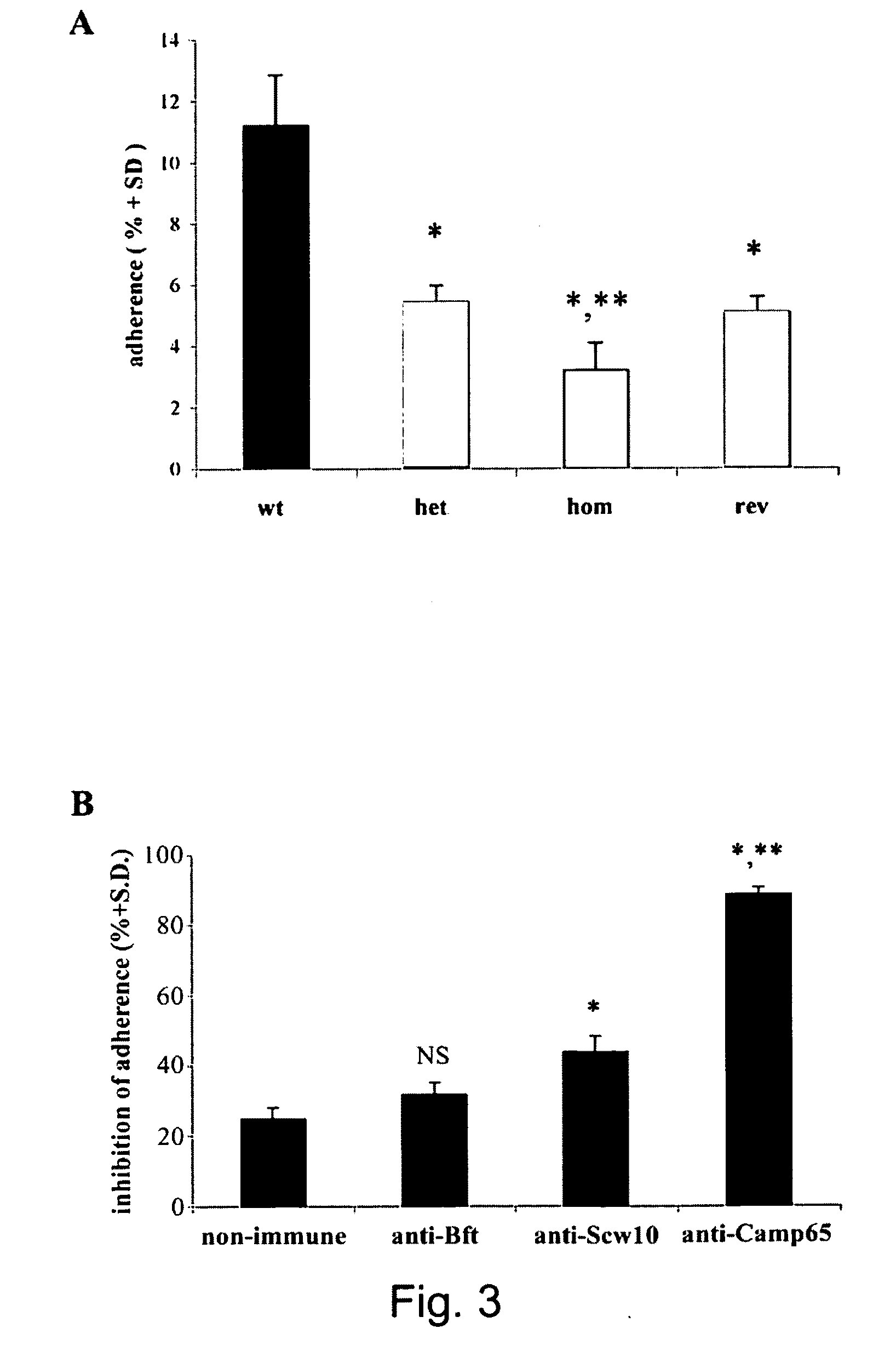Medicaments for fungal infections
a technology of fungal infections and medicaments, applied in the field of medicaments, can solve the problems of unformally investigating the biological and virulence properties, if any, of this protein, and the limited anti-fungal treatment options, and achieve the effect of reducing the resistance of the fungus to clearance and weakening the ability of
- Summary
- Abstract
- Description
- Claims
- Application Information
AI Technical Summary
Benefits of technology
Problems solved by technology
Method used
Image
Examples
example 1
Microorganisms and Growth Conditions
[0052]Escherichia coli XL1 blue (endA1, hsdR17, supE44, thi1, recA1, gyrA96, relA1, Δlac, [F', proAB, lacIqZΔM15, Tn10] and M15 (nalS, strS, rifS, lac−, ara−, gal−, mtl−, F−, recA+, uvr+, [pUHA1]) were used as host strains for recombinant plasmids. E. coli strains were grown in L-broth (1% tryptone, 0.5% yeast extract, 0.5% NaCl, pH 7.0) and Luria Bertani (LB) plates (1% tryptone, 0.5% yeast extract, 0.5% NaCl, 1.5% agar, pH 7.0) supplemented when necessary with ampicillin (100 μg / ml) or tetracycline (12.5 μg / ml) (La Valle et al., 1995).
[0053]Candida albicans strains used in this study are listed in Table 1. They were routinely cultured on Yeast-peptone-dextrose (YPD; 1% yeast extract, 2% bacto-peptone, 2% glucose, all w / v) or Yeast Nitrogen Base (YNB; 2% glucose, 0.17% yeast nitrogen base without amino acids and ammonium sulphate, 0.5% ammonium sulphate, w / v) or Winge (0.3% yeast extract, 0.2% glucose) or SDB (1% bacto-peptone, 2% dextrose) media...
example 2
Plasmid and Strain Construction
[0057]To construct the CAMP65 disruption plasmid, the 3.8 kb fragment, obtained by BamHI-Bgl II digestion of p5921 (Fonzi and Irwin, 1993), was cloned into the BclI sites of pRLV139 (La Valle et al., 2000) in order to delete a 348 bp fragment of CAMP65 (spanning from nucleotide 150 to 498 of coding sequence) and insert the hisG-URA3-hisG marker thus constructing the pRLV140 plasmid. The pRLV140 construct was then digested with KpnI and PstI, and used to transform the ura−C. albicans strain CAI4 (wild type) by a lithium acetate-based transformation protocol as described elsewhere (Fonzi and Irwin, 1993). Ura+ prototrophs were selected on YNB medium. The heterozygous CAMP65 / camp65::URA3 strain RLVCA4 (het1) was plated onto 5-FOA-containing YNB plates to obtain the ura3 heterozygous RLVCA8 strain (het1 ura3). A second cycle of disruption was performed to generate URA3 homozygous CAMP65 strain RLVCA31 (hom1), which was then subjected to a second cycle of 5...
example 3
Polymerase Chain Reactions (PCR)
[0061]To amplify CAMP65 locus for cloning, PCR reactions were performed on a Gene Amp PCR System 9600 apparatus (Perkin Elmer Roche), in a volume of 100 μl containing 20 mM Tris-HCl pH 8.8, 10 mM KCl, 2 mM MgSO4, 10 mM (NH4)2SO4, 1% Triton X-100, 1 mg / ml nuclease-free BSA, 200 μM of each deoxynucleotide, 0.5 μM of each primer (Table 3), 5 unit of native Pfu DNA polymerase (Stratagene, La Jolla, Calif., USA) and 100 ng of fungal DNA that was purified with GFX Genomic Blood DNA Purification kit (Amersham, Pharmacia). PCR was done using the following protocol: initial denaturation at 95° C. for 45 s followed by 25 cycles of denaturation at 95° C. for 45 s, annealing at 49° C. for 45 s, extension at 72° C. for 4 (for Ca72 and Ca73) and final extension at 72° C. for 10 min. To control the CAMP65, URA3 and RPS1 loci in wild type and mutant strains, the general protocol described above was used with the following little differences: the final volume of react...
PUM
| Property | Measurement | Unit |
|---|---|---|
| Electrical resistance | aaaaa | aaaaa |
| Adhesion strength | aaaaa | aaaaa |
| Antigenicity | aaaaa | aaaaa |
Abstract
Description
Claims
Application Information
 Login to View More
Login to View More - R&D
- Intellectual Property
- Life Sciences
- Materials
- Tech Scout
- Unparalleled Data Quality
- Higher Quality Content
- 60% Fewer Hallucinations
Browse by: Latest US Patents, China's latest patents, Technical Efficacy Thesaurus, Application Domain, Technology Topic, Popular Technical Reports.
© 2025 PatSnap. All rights reserved.Legal|Privacy policy|Modern Slavery Act Transparency Statement|Sitemap|About US| Contact US: help@patsnap.com



